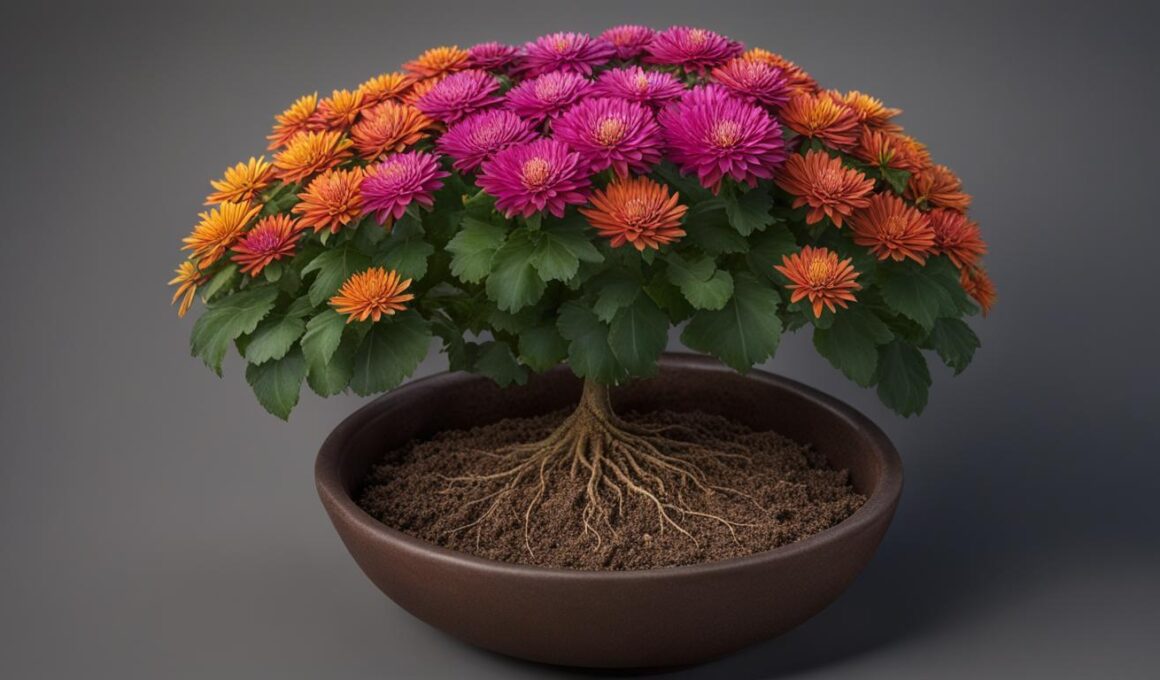Are you wondering what to do with your blooming mums once they have finished flowering? Can you plant them again and enjoy their vibrant blooms in the next season? In this article, we will explore the possibility of planting mums after they bloom and provide you with valuable tips on caring for blooming mums.
Post Summary
- Choose chrysanthemums with mostly closed buds and healthy foliage for prolonged attractiveness.
- Flowers generally last about two to three weeks, depending on outdoor temperatures.
- Garden mums can be grown in containers or planted in beds with existing shrubs and flowers.
- Cut back and trim faded flowers after they finish flowering.
- In late winter or early spring, cut back the plants to encourage new growth.
How to Plant and Care for Blooming Mums
If you want to enjoy the beauty of blooming mums in your garden, it’s important to know how to properly plant and care for them. By following these tips, you can ensure the successful growth and longevity of these vibrant flowers.
Planting Blooming Mums
To give your mums the best chance of thriving, choose a well-drained area in your garden that receives at least six hours of sunlight daily. Mums prefer soil that is rich in organic matter, so consider adding compost or other organic amendments before planting. Dig a hole that is slightly larger than the root ball of the plant, and gently place the mum into the hole. Backfill with soil, firming it gently around the roots. Be sure to water the plant thoroughly after planting to help it establish.
In colder regions, it’s best to plant mums in the spring to allow them ample time to establish themselves before winter. However, if you’re planting in the fall, do so as early as possible to give the plants the best chance of survival. Adding a layer of mulch around the base of the plants can help protect them from harsh winter temperatures.
Caring for Blooming Mums
After the mums have finished flowering, it’s important to remove the faded flowers to encourage new growth and additional blooming. This process, known as deadheading, helps the plant allocate its energy towards producing more flowers rather than forming seeds. Simply pinch off the dead blooms at the base of the stem.
Throughout the growing season, regular watering is essential to keep the mums hydrated. Be sure to water deeply, allowing the soil to dry slightly between waterings. Applying a balanced fertilizer every 4-6 weeks can also help promote healthy growth and abundant flowering.
Lastly, to keep your mums compact and bushy, consider pinching them back during the spring and early summer. This involves removing the top inch or two of growth on each stem, which encourages the plant to produce more branches and results in a fuller, more vibrant display of flowers.
By following these planting and care tips, you can enjoy the beauty of blooming mums in your garden year after year. With their vibrant colors and stunning blooms, mums are a wonderful addition to any garden or landscape.
| Planting Tips for Blooming Mums | Care Tips for Blooming Mums |
|---|---|
| Choose a well-drained area that receives at least six hours of sunlight daily | Regularly water deeply, allowing the soil to dry slightly between waterings |
| Prepare the soil by adding organic matter | Pinch off faded flowers to encourage new growth and additional blooming |
| Plant in the spring for best results, or early in the fall | Apply a balanced fertilizer every 4-6 weeks during the growing season |
| Water thoroughly after planting to help the mums establish | Pinch back the plants in the spring and early summer to promote bushiness |
| In colder regions, consider adding a layer of mulch for winter protection |
The Difference Between Florist Mums and Garden Mums
When it comes to chrysanthemums, there are two main types that you’ll come across: florist mums and garden mums. While they may look similar at first glance, there are some key differences between these two varieties. Understanding these differences is crucial when it comes to choosing the right type of mum for your gardening needs.
Florist Mums
Florist mums, as the name suggests, are primarily grown and sold by florists. These mums are specifically bred for the florist trade and are often sold as potted plants. They are known for their vibrant and eye-catching blooms, making them a popular choice for floral arrangements and gift-giving occasions. However, it’s important to note that florist mums are typically not as hardy as garden mums and may struggle to survive the winter if planted in the ground.
Garden Mums
Garden mums, on the other hand, are more commonly found in home gardens and landscaping projects. These mums are bred to be hardy and can withstand various weather conditions, including colder winters. Garden mums have stolons, which are runners near the surface of the ground that put out new roots and shoots. This allows them to be perennial, meaning they can come back year after year if properly cared for. With their ability to withstand the elements and their longevity, garden mums are a popular choice for many gardeners.
| Florist Mums | Garden Mums |
|---|---|
| Primarily sold as potted plants by florists | Commonly found in home gardens and landscaping projects |
| Bred for vibrant and eye-catching blooms | Bred to be hardy and withstand various weather conditions |
| May struggle to survive the winter if planted in the ground | Can come back year after year if properly cared for |
When selecting mums for your garden or floral arrangements, it’s important to consider your specific needs and preferences. If you’re looking for short-term blooms for an event or gift, florist mums may be the better choice. However, if you want long-lasting, reliable mums that can return year after year, garden mums are your best bet. Whichever type you choose, both florist mums and garden mums can add beauty and color to your outdoor spaces.
Tips for Planting and Overwintering Mums
To ensure successful overwintering of your mums, it’s crucial to follow proper planting and care techniques. Here are some tips to help you get the most out of your blooming mums during the winter months:
Planting Mums for Overwintering
- Choose a well-drained area in your garden with full sun exposure for planting mums.
- Plant them in the spring or early fall to give them enough time to establish their root systems.
- Prepare the soil by adding compost or organic matter to improve drainage and fertility.
- Dig a hole slightly larger than the root ball of the mum and place it in the hole, ensuring the crown is at or slightly above ground level.
- Backfill the hole with soil, firming it gently around the roots, and water thoroughly.
Caring for Mums in Winter
Once winter arrives, it’s important to provide the necessary care to protect your mums from cold temperatures and harsh weather conditions. Here’s what you can do:
- Apply a layer of mulch around the base of the plants to help insulate the roots and retain moisture.
- Consider using a frost blanket or burlap to cover the plants during extreme cold snaps.
- Avoid overwatering during the winter months, as excess moisture can lead to root rot.
- Monitor the plants for any signs of disease or pest infestation, and take appropriate action if needed.
By following these tips, you can increase the chances of successfully overwintering your garden mums and enjoying their beautiful blooms year after year.
Common Hardiness Zones for Mums
| Hardiness Zone | Temperature Range (°F) |
|---|---|
| Zone 3 | -40 to -30 |
| Zone 4 | -30 to -20 |
| Zone 5 | -20 to -10 |
| Zone 6 | -10 to 0 |
| Zone 7 | 0 to 10 |
| Zone 8 | 10 to 20 |
| Zone 9 | 20 to 30 |
Conclusion
In conclusion, with proper care and maintenance, blooming mums can continue to add beauty to your fall garden for many years. When purchasing chrysanthemums, make sure to select plants with mostly closed buds and healthy foliage. This will ensure that the flowers last longer and remain attractive.
It’s important to plant blooming mums in well-drained beds with at least six hours of daily sun exposure. This will provide them with the necessary conditions for successful growth. After the mums finish flowering, be sure to cut back the faded flowers to encourage new growth. This will help the plants come back again the following year.
If you live in a region with colder winters, it’s a good idea to provide protection for the mums during the winter months. Covering them with bark mulch or leaves can help protect them from extreme temperatures. Knowing the hardiness zone of your area can also help determine the best approach for overwintering the mums.
By following these tips, you can enjoy the beauty of mums in your garden year after year. With a little care and attention, these lovely flowers will continue to brighten up your outdoor space throughout the fall season.
FAQ
Can I plant mums after they bloom?
Yes, you can plant mums after they bloom. However, it’s important to select plants with mostly closed buds and healthy foliage for best results. Plants that are already in full bloom will not be attractive for a long period.
How do I plant and care for blooming mums?
To plant blooming mums, choose a well-drained bed that receives at least six hours of sun daily. Plant them before winter to give them enough time to establish themselves. After they finish flowering, cut back the plant to remove faded flowers. Consider providing protection for the plants during winter in colder regions. Pinch off dead blooms to encourage new growth and additional blooming.
What is the difference between florist mums and garden mums?
Florist mums are typically sold as potted plants and are bred for the florist trade. They are less hardy than garden mums and may not survive the winter if planted in the ground. Garden mums, on the other hand, are more reliable and can return year after year. They have stolons, which are runners near the surface of the ground that put out new roots and shoots, allowing them to be perennial. Choose the right type based on your intended use.
What are some tips for planting and overwintering mums?
For successful overwintering, plant mums in the spring or divide and plant in the fall, if done early enough. Plant them in full sun and well-drained soil. Pinch them back during the spring and early summer to keep them compact. Cut back the dead blooms to encourage new growth. Provide protection for the plants during winter in colder regions by covering them with mulch or leaves.
What should I keep in mind about blooming mums?
While blooming mums may only last a few weeks, with proper care and maintenance, they can continue to bloom in the fall garden for many years. Choose plants with mostly closed buds and healthy foliage when purchasing chrysanthemums. Plant them in well-drained beds with at least six hours of daily sun exposure. Cut back faded flowers after blooming and provide winter protection in colder regions. By following these tips, you can enjoy the beauty of mums in your garden year after year.
Can I Plant Mums in the Ground After They Have Been in Pots?
Yes, you can plant mums in the ground after they have been in pots. Mums in pots perennial cycle is common practice among gardeners. Once the mums have finished blooming, you can transfer them to the ground. Just make sure to choose a suitable location with well-draining soil and ample sunlight.
Source Links
- https://www.nola.com/entertainment_life/home_garden/should-i-toss-my-potted-chrysanthemums-after-they-bloom-heres-what-to-know/article_29c7b01a-e036-5a6b-b910-d7e1c281fcc2.html
- https://buffalo-niagaragardening.com/2016/07/05/trick-to-get-mums-to-come-back-every-year-plant-them-now/
- https://spottsgardens.com/perennial-mums-do-mums-come-back-return-of-the-mums/










